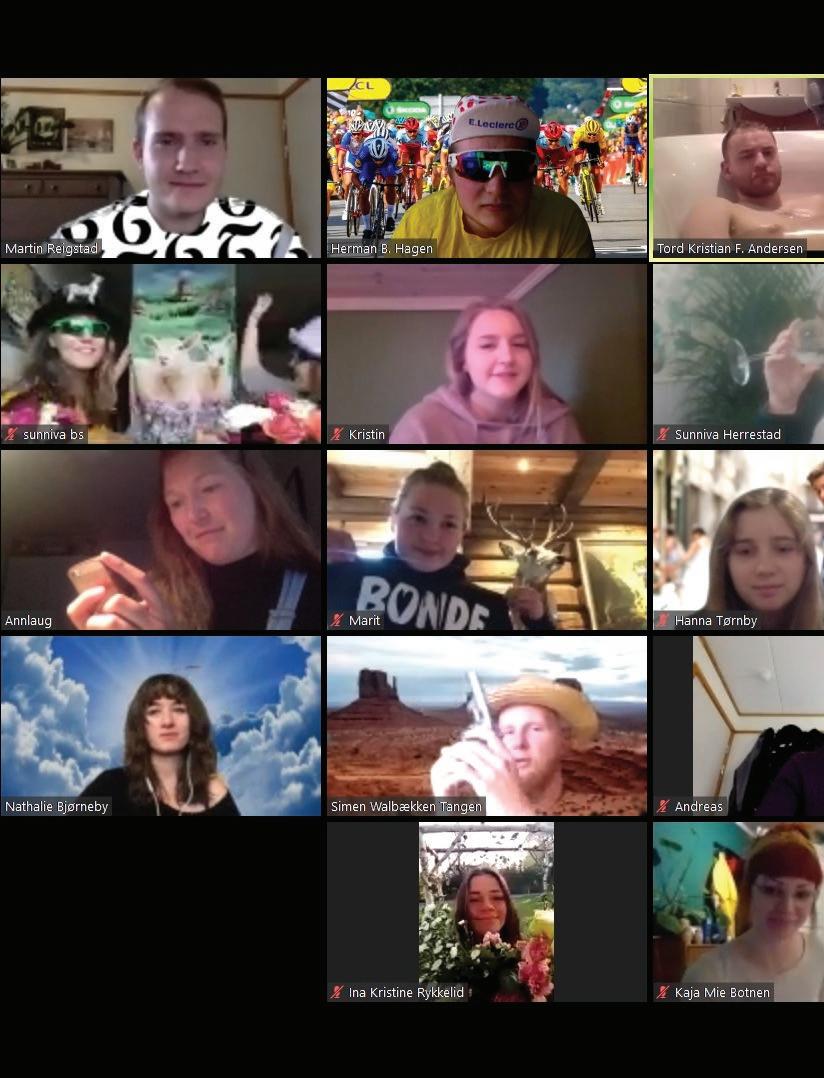
25 minute read
How are the theses affected by Corona?
from TT05 English
by Tuntreet
Writing a thesis in the Corona Times
The semester has been different for all of us, but for students writing a bachelor’s or master’s thesis, the situation may feel even more difficult. What are the new guidelines for the theses, and how has the altered everyday life affected the work?
Advertisement
Sofia Basma Moen Journalist
Hanna Bruun Tørnby Photographer
Nora Helgeland Translator
Deferred deadline and online guidance
All theses with a deadline of May 15th have been postponed to June 2nd. The submission is electronic, and no printed copies are required. Also, medical certificates are not required for applications for further postponements of the deadline, but you must attach an approval from the supervisor. Guidance is held over Zoom or Skype.
If a student did not complete the necessary lab, field work or the like before the situation arose, the student is responsible for contacting their main supervisor to clarify how the assignment will be worked on. Each case will be assessed individually.
Most have been negatively impacted
Thus, students writing their thesis this spring have had their lives turned upside down. Tuntreet has investigated how the students themselves have experienced the situation. As many as 84% say the situation has negatively affected their task. 13% do not think the degree thesis has been particularly affected, and only 3% state that the situation has actually affected the thesis positively.
22% will still deliver the task on May 15th, despite the extended deadline. Almost half state that they have not received as much guidance as planned. Over 50% have also not benefited as much from the guidance, but 25% think online guidance has worked well. One third have had to alter the topic of their thesis due to the situation.
Lots of challenges
When asked what the biggest challenges have been, these answers are recurring: poor guidance, less motivation, lack of good routines, access to printer, lab data and necessary software, and not being able to sit with a partner or others who write theses.
What has been the biggest challenge?
“That a lab master is now theoretical. An everyday life with a good distribution of practical work and writing is now just writing every day.”
“Working at home when the others in the collective are fucking noisy.”
“Missing my reading room space. Not being able to separate workplace and a place to “chill” feels all wrong.”
The General Assembly of Samfunnet is coming up, and there are many questions that pop up in advance. Resigning people from various positions showed up for an open question hour Wednesday April 22nd, and this time it happened online.
Positions that are up for election:
Jane Bergan Journalist Aleksander Mæland Munkejord Translator
Board of Samfunnet:
Leader (2 periods) Chief of Economy(3 periods) Chief of Marketing (2 periods)
Business Committee:
Manager of Events (2 periods) Manager of Sponsors (2 periods) Manager of Career Day (3 periods
Tuntreet:
Editor in chief (2 periods) Core members board: Student representative (2 periods)
Election Committee:
Two representants (2 periods)
What will the GA be like? How do we “meet” the representatives?
According to leader of the Board of Samfunnet, Oscar Mork, there will presumably be shown short videos of the representants speeches, each of around

three minutes. Following the speeches, there will be room for questions regarding each election.
Is anything currently happening at Samfunnet?
According to the Chief of Events Ruben Rygh, Samfunnet is a bit “put on hold”, but it’s far from closed. Quizzes are streamed, there’s an art competition, and the event group is well on their way in shaping the next semester.
Why should I bother running for positions at the GA? Isn’t it a lot of work?
Besides attending meetings, you can pretty much do what you want with the time as a representative. A lot has happened at Samfunnet the past six months – for example an agreement of serving, and another organization structure has been decided upon. The system is up and running, and there is a need for new, creative ideas. It’s quite rewarding to be an active part of practical changes!
What’s the best and worst parts of having a position?
Everyone agreed that the best, without a doubt, is getting to know your fellow students, making a difference and learning how things work behind the scenes. Of course, different positions come with different drawbacks. The leader has lots of paperwork. NU and Marketing finds the worst part to be all the current cancellations and not having anything to do (hopefully a one-time event). The Chief of Economy puts a lot of hours into the yearly financial statement. While the editor finds the worst part to be how quickly the period is over.
What measures are planned to integrate the veterinary students?
They carry their own traditions, such as their larva review and barn party, which they will keep doing, and we are making an attempt at some sort of fusion. We’ll try to adopt some of their traditions – they bring competence and we have the resources. Tuntreet will try cooperating with their student media, and everyone will do their best to wish them a warm welcome, even though their arrival is postponed until the winter.
What should I expect from future leaders at Samfunnet?
They should be able to stay neutral and make sure everyone is heard, and lead discussions. It is also important that they know the organization and the function of Samfunnet. This year there will be put more focus on facilitating the community services. For example for the veterinary students working morning shifts, which makes community services on late nights a challenge.
How much time do the different positions require for meetings and other “work”?
The Board holds meetings on Mondays, lasting anywhere from 45 minutes to 4 hours, while the Core members board meet less frequently. Marketing does a lot of preparation during summer break and buddy week, but the rest of the year is more relaxed. The Chief of Economy spends a lot of time approving accountings, following up on budgets and sponsor agreements. Party night budgets take a good number of hours, as Samfunnet has learned from UKA that it’s wise to have separate budgets for each event. The Editor of Tuntreet has meetings 1-2 times each week, sits in the office and takes part in the layout weekends
every third week, which last the entire weekend. NU holds meetings once a week and does a good bit of e-mails and phone calls – but the workload differs largely from one month to the next.
MOVING FROM ADAMSTUEN POSTPONED for 6 more months

Guro Størdal Journalist
Simen Walbækken Tangen Photographer

Eirin Aasland Translator
During the fall of 2020, the veterinarians were supposed to finally move from Adamstuen to Ås. It seemed that after several delays everything would finally be ready for the next school year, but due to corona the moving is now postponed for another 6 months. The veterinarians are still hanging in there.
Edel Enger Optun is the head of the veterinary medicine student council, and is tired, yet understanding, of the whole situation. Thea Scheide, who is in the moving committee, feels the same way. They say that the management have done the best they can to inform, but there is a lot of uncertainty at the moment. They are trying to adapt to the situation as best they can, and have come up with some good solutions already. cannot deliver to Statsbygg, who is the project managers of the construction work. The construction project is now awaiting special equipment needed for educating. They depend on getting this delivery from abroad, and can not do anything other than wait. Hopefully, the project can start back up this fall, but they are prepared for further delays.
Challenging living situation
The students were prepared to move, and several have ended their contract at the student housing in Oslo and have signed the contract for student housing in Ås. The students have been worried that there are few housing options who allow pets, And it can be difficult to get into the housing market in Ås. Things seemed to work out with housing, but when the semester start was postponed, more worrying came along. Luckily, SiO and SiÅs were quick to get involved with a helping hand.

Thea Scheide has been in the moving committee since the start of 2019. The committee was created in 2015 to answer questions from the students and be a bridge between the management and the students regarding the move.


Some can continue to live with SiO, but Edel and Thea predict that many will have to commute from Ås to Oslo. Edel Enger Optun is the President of the veterinary medicine Student Council
The eduation can continue like before
They say that the courses and teaching can continue at Adamstuen. The challenges will be the same as before; limited room and a lack of modern equipment, but since nothing has been transferred to Ås yet, everything can continue like it used to. The moving list has been ready since the 1st of November 2019, so when it is ready to move in, it should go fairly easily.

Moving may clash with exams
The actual move is expected to take some time, as there is a lot of equipment and a lot of special equipment. This can lead to some challenges as the semesters are built into blocks. They essentially have one course at a time, with an exam after only a few weeks. The moving can therefore end in the midst of their exam period. “The best would have been if the moving could have happened during the summer period, which is what we had planned for.”, Thea explains.
Involved and excited students
It is not just the practicalities around moving that is affected by the delays. Fadderuka would also have been a part of settling in to the new environment in Ås. It will also be more difficult for the students to participate in events during the fall semester. Edel and Thea are not very concerned about the effects the delays will have on the integration of the students, but believe that the best would have been to get a collective start at University. “Many veterinarian students are good at engaging A lot of activity was supposed to happen here from the fall semester, with almost 500 new students.
themselves. We had a counting and found out that within the 500 students there are 22 teams and unions that do everything from climbing to sowing to choir”, says Thea.
Outdated equipment
Edel shares that the attitudes around moving seems to have changed within the last few years, and that the newest students are well prepared for the move. “Most of them are looking forward to a new school and more space, where the equipment is fitted to the changes in the profession.”, she says. Thea explains that when Adamstuen was built, it was livestock and labouranimals who were the main focus. Today it has changed to sports- and family pets.
Still new info
Now they are waiting for new info from Statsbygg within the end of April, and they will then know more about what is to come. They are in good communication with the management, and are ready for changes if they are needed. It will be exciting to see how the situation evolves, but both Edel and Thea is looking forward to moving in, “when we first get there”.
F R OM B R A Z I L PERSP ECTIVES

By Jardar Lindaas Bringedal (MINA-student)
The host University had given us a short description of how we were supposed to travel from the airport in Piracicaba, that was much appreciated. By using body language and precise pointing at the name of first town I had to visit, I was finally on my way. I was quite nervous. I had just landed in Brazil, and was ready for a year in the Portuguese speaking country. Already at the biggest airport of South America I confirmed both my minimal knowledge of Portuguese, and the absence of English knowledge in the Brazilian society.
I was fortunate enough to have good grounds for learning Portuguese. I lived with seven Brazilians, and all my subjects were taught in Portuguese. In addition to this, the group of exchange students here was not that big, and the majority of them were French. As an exchange student in a country where you do not master the native language before arriving, you get insight on what it must be like for those who change their country of residence against their will. The respect and understanding for these people skyrocket when realising how big of a task this is.
I chose to go on exchange to Brazil because I wanted to try something new and different. When my Brazilian friends ask me about Norway, I reply saying its completely opposite. In Norway you are safe, but not in Brazil. In Norway, people are more closed off, while in Brazil they are more open. In Norway it is cold, but in Brazil it is warm. We follow the rules in Norway, but not so much in Brazil. In Norway there isn’t much of a hierarchy between people, but it is in Brazil, and so on…. By experiencing these differences, you become more conscious of your own country while at the same time learning about a completely different culture. receiving more opportunities to acquire important grades earlier on to grasp how you were doing in the subject. As a last-minute cramming student, this was an entirely new reality.
After a successful semester, the cherry on top of the cake was definitely the three month long summer break. During my break I got to know Rio de Janeiro and São Paulo, before celebrating Christmas with a Brazilian friend and his extended family, which is something that is far from a normal Norwegian Christmas. New Years eve was celebrated with friends on a beach, before catching a bus up to the north eastern beaches of Brazil. Here, I got to know the history of Brazil, about the colonization period and the African influence from the slavery. And last but not least, the long beaches, national parks and the 3000km long bus ride from Fortaleza to São Paulo.
The second semester started in the middle of February, but as they say in Brazil: “The new year doesn’t start properly until after Karneval”. And with that, I didn’t get to properly start until after the beginning of March, and after two weeks of March, my Brazilian adventure was over for now.

I also wanted to familiarise myself more with Brazil because I wanted to get to know the Amazon better. In less than two months after I arrived in Brazil, Piracicaba was covered by smoke clouds from the fires in the Amazon. Two months after I was in the Amazon with the forestry-engineers from the University. We got to see what its like to do legal and sustainable forestry. We also learned and discussed the challenges with illegal forestry and use of forests.
The first semester was mainly studying and learning Portuguese. The university had mandatory lectures and we had tests throughout the entire semester. This required us to study as the semester progressed, while

Main building at ESALQ (1 of 7 campuses at the University of São Paulo, Brasil’s oldest Agricultural University)
Norwegian Nynorsk at NMBU

There are many types of minorities in our society today. One of those are those who use Norwegian Nynorsk. They are a minority at both NMBU and elsewhere in our society. How is it to be a student who uses Norwegian Nynorsk as their main written language?
Marit Andrisdotter Kvam Journalist
Oda Braar Wæge Illustrator
Tilde Milia Skaatun Translator
Tuntreet has investigated this in a recent survey. We have also spoken to Studentmållaget in Ås, who work especially with Norwegian Nynorsk users, and with putting the language in a positive light.
Not a dialect
Norwegian Nynorsk is a much-debated language. Some think it is a dialect you speak, others call it only a secondary language form. The truth is that in Norway we have two official written languages as stated in the constitution; Norwegian Nynorsk and Norwegian bokmål. Despite there being a lot less users of Norwegian Nynorsk than Norwegian bokmål, they still have a right to use their own written language.
NMBU has a language committee. Their responsibility is to enforce and maintain the language policies at the university. The committee’s main goal is “Development and management of the academic language (Norwegian bokmål, Norwegian Nynorsk and English) and parallel languages (Norwegian-English).”
A simple survey from Tuntreet would not be enough to explain the situation today and if the language committees work is effective or not, but it can give an indication.
Poorly enforced, good attitudes
We asked Norwegian Nynorsk users how the experience of using the language at the university has been. A whole 42,9% say the experience has been bad. 33,3% on the other hand, say the experiences have been good.
Together with how the general experience has been, we also asked how they perceive the universities general attitude towards Norwegian Nynorsk users. Rated out of five, 50% answers four or five, 30% answer two, and 20% answer three.
The Nynorsk Norwegian crowd is a bit of a divided group when it comes to their experiences. Most of them perceive the university to have a relatively good attitude towards the users.
Many of the experiences can be due to onetime incidences where one has felt ignored. The attitudes of university representatives, such as those responsible for courses, can also have an impact. Their attitudes or opinions often come through as negative.
Exams
The experiences surrounding exams usually awoke many reactions. 23,8% of those who answered the survey, say they often do not

Game night at Ås Studentmållag this fall.
get exams in their written language. 33,3% say they get it occasionally. Many have been asked by their course supervisor if they really need to get the exam in Norwegian Nynorsk, because the supervisor feel its wasted time to translate the exam. Some have also experienced the language of the Norwegian Nynorsk exam to be so bad that it caused them to fail. When they then have to re-take the exam, they had to take the Norwegian Bokmål version.
Some feel that they receive poorer grading because they write using Norwegian Nynorsk. This is only from personal experience, and something one cannot prove, but after having to deal with the general attitudes towards the language, it does beg the question.
Another common “problem” is group assignments. If most of the members use Norwegian Bokmål, you adapt to them. This is usually ok, but many find it to be an annoyance.
Information
The NMBU homepage is in Norwegian Bokmål. Fine enough. The most important thing is that you find the information you need. Most of the textbooks are sourced externally, and in English. But NMBU does write some of its own teaching material and compendiums. These are hard to find in Norwegian Nynorsk.
It does make sense that translating involves an added expense for the university. Despite this, it is still frustrating to write reports, assignments and such in Norwegian Nynorsk, while having to spend time translating the terminology.
A desire to be seen
Studentmållaget in Ås is following the issues surrounding the written language closely. They say that one of the biggest issues is that many students switch to using Norwegian Bokmål instead. A research done in 2009 showed that 75% of the Norwegian Nynorsk users in Valdres, switched to Norwegian Bokmål during their 13 years in school (Garthus and others, 2010). When asked why, they said Norwegian Bokmål is what they see in the media, books and newspapers. Thus, it seemed easier to write using Norwegian Bokmål. Maybe they would have kept using Norwegian Nynorsk, if they had seen it used more widely?
One of our goals is therefore to make Norwegian Nynorsk more visible in dayto-day life. For many, Nynorsk Norwegian is considered to be a school only language, but in reality, Nynorsk is a everyday language for hundreds of thousands of Norwegians throughout Norway.
Everyday measures
Studentmållaget have a few solutions to how they can increase the use of Norwegian Nynorsk. They feel it is important to see the language when you move about in society, either it is at the grocery store, on campus, on the news or at the cinema.
Board members of Ås Studentmållag 2020. From the left: Simen Rønnekleiv Eriksen, Martine Molland og Rune Holsen Nygård. Absent: Janne Birgitte Ueland.

Studentmållagets everyday measures for Norwegian Nynorsk:
- As a student, computers and telephones are something one cannot go without. Why not change the language to Norwegian Nynorsk? Windows, Microsoft Office, Google, Facebook and even Canvas supports Norwegian Nynorsk. Even Minecraft. - Use Norwegian Nynorsk everywhere! On the grocery list, Instagram, assignments, and especially exams! Remember to ask for exams in Norwegian Nynorsk, this is one of your rights. By actively using the language, others can also get used to seeing it as an everyday language. - Watch and read material in Norwegian Nynorsk. NRK managed for the first time in 2019 to make 25% of their material in Norwegian Nynorsk. And have you noticed that Eides language-show now runs prime time on Saturdays? Tuntreet is also an avid user of Norwegian Nynorsk. - Give Studentmållaget in Ås a like on Facebook, and join our events!
A matter of principle
It is easy to pull out the «offended»-card when discussing whether or not we actually need two written languages in Norway. Why should the small minority of Norwegian Nynorsk users take up so many resources? Many have used the language all their life. It is what is most natural for them. It is also a matter of principle. We want exams in Norwegian Nynorsk. It is not that we do not understand Norwegian Bokmål. You have a right to take exams in your preferred written language. You should not be met with negativity from those who represent the university. It is not as difficult as one would think. Norwegian Nynorsk users are not a type of their own, they just want equality.

Cultivated land must give way to centre of expertise
Petter Nielsen Journalist
Natalie Genvieve Bjørneby Photographer

Nora Helgeland Translator
A new competence centre for water infrastructure is coming to NMBU and will occupy 13 hectares of food soil. The centre is requested by the industry and the desire to place it in Ås is justified by the opportunity to collaborate with NMBU. The building of the competence centre was recently voted through by the municipality.
The matter was considered for the first time in June 2019, and it was decided that a plan proposal could be prepared. This is despite the fact that the development area has been set aside for land use purposes LNF-A (Agriculture-, Nature- and Outdoor Area). The reason why this is particularly noteworthy is that in areas allocated to the LNF in the municipal plan, construction activities that are not directly linked to agriculture and traditional agricultural activities are not allowed.
Contested development
NMBU owns the land where the centre is planned to be located and many find it provoking that NMBU, as an agricultural university, wants to downsize cultivated land. When the matter was up for final consideration in the municipal council, many of the parties were critical of the location, and 12 out of 33 voted against the plans for development. These were MDG, SV, SP, KRF and Rødt. Several of the parties’ representatives have stated that it is important to preserve cultivable land and they hope that their vote against the proposal will send a signal to NMBU that they should choose other areas.
The remaining parties pointed out that the centre will contribute to new jobs and increased competence in the municipality, and stated that the project had a lot of positive sides which were difficult to deny.

It was mentioned that the competence centre could provide environmental benefits for the entire country, and that it is unfortunate if a project that has come so far in planning, is cancelled.
Food safety
Due to the corona pandemic, more attention has recently been focused on the degree of self-sufficiency in Norway. It has been pointed out that Norway depends on imports from abroad to have sufficient amounts of food. Since almost all major cities and towns in Norway are built close to food soil, these areas are often used when urban areas are to be expanded. It is a pity that NMBU, which has the opportunity to be an example and to take the lead in the battle not to demolish food soil, selects such a location.
Contradictory?
Ås municipality considers the detailed regulation a good framework, and points out that the water infrastructure centre will strengthen Campus Ås as an environment of knowledge. They conclude in their detailed regulation plan that the proposed plan for construction of the competence centre has been prepared satisfactorily and that all comments that have been submitted have been taken into account. They have, as a mitigating measure, demanded the preservation of food soil for new cultivation or improvement of existing land elsewhere, which may seem contradictory.
What does NMBU do in the fight against corona?

Sofia Basma Moen Journalist
NMBU contribute in the fight against the corona virus in several ways. Over 130 employees and students have signed up as reserve personnel. Additionally, various equipments have been developed and given away as a loan, and at the homepages for the University one can find many articles about the corona situation.
Photo: Hank Williams, Pixabay Eirin Aasland Translator
Infection control eye-glasses
A group of students at NMBU have produced 160 infection control glasses for the general practitioners in the Ås municipality. This happened two days after the Health Directory encouraged voluntary work to produce infection control equipment. Eik makerspace took charge in developing the glasses. The instructions came digitally, and the voluntary work was done at home. The glasses were original designs and made from plastic plates, with the hospital in Østfold providing the spesifics. They were laser cut, which only takes two minutes to make one pair of glasses. Eik makerspace has also produced around 10.000 buttons for infection control coats.
Research articles
NMBU has several professionals who are active in the media in regards to the Corona pandemic. At the University website, one can read several articles about the Corona situation written by researchers at NMBU. Among other things, they talk about what happens when animals transfer infectious diseases to humans, and the possibility of treating the virus with the same medication used against HIV, malaria and Ebola. There are also articles about how the corona virus is leading to internal migrations in India, and about the consequences of the Corona virus spread in Africa.
Detect viruses in the wastewater
Furthermore, researchers from NMBU are working on finding answers to whether or not the virus is detectable in wastewaters. The virus propagate in the intestines and end in the drainage. If the amount of virus is high enough, it could be detectable by sampling the wastewater that are run through the treatment plants. This can be useful for following the development of the Coronavirus in Norway, but also to detect new viruses in the future.
Respirators sent to hospitals
NMBU, the Hospital in Stavanger (SUS) and the University in Stavanger have a research- and teaching centre in Sandnes called SEARCH. SEARCH has sent lifesaving equipment such as respirators, syringe pumps and patient monitors to the Hospital in Stavanger. The respirators lent to SUS are normally used in the veterinarian students’ education.

Runa Gjerland Cartoonist

Turntrener søkes!

Spydeberg Turnforening søker ny turntrener til 11+ konkurranse.
Vi startet opp et konkurranseparti i troppsgymnastikk høsten 2017, og søker hovedtrener til dette partiet fra høsten 2020 to dager i uken.
Vi håper at akkurat du er vår rette person.
Les mer om stillingen på vår Facebookside: https://www.facebook.com/SpydebergTurnForening The above is a job ad for an artistic gymnastics teacher
Editorial staff spring of 2020

Reconnecting...









A NEW COMMITTEE MEMBER









